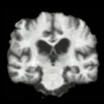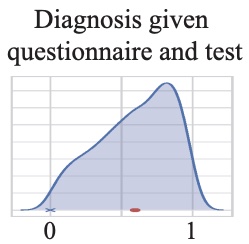
Brain MRI from a subject with Alzheimer's disease, from the Open Access Series of Imaging Studies (OASIS) dataset.
Alzheimer's Disease
Characterizing brain shapes allows clinicians to quantify the progression of Alzheimer's disease. Pushing the frontiers of our understanding of this disease often mean to compare a new subject's brain shape with a pre-computed "template" brain shape, i. e. the standard shape for a healthy subject.
Our research explores statistical learning on brain shapes, and:
- studies methods allowing to compute with brain shapes in the small data regimes (smaller dataset sizes),
- quantifies the uncertainty associated to the computation of a brain's template, which impacts the uncertainty associated with the extraction of novel medical knowledge.
Paper Spotlight:
Nina Miolane, Susan Holmes, Xavier Pennec. "Topologically Constrained Template Estimation via Morse--Smale Complexes Controls Its Statistical Consistency." SIAM Journal on Applied Algebra and Geometry 2.2 (2018): 348-375.

Taking the pill causes structural changes in the brain regions that control memory and emotion.
Women's Brain Health
Most of what we know about health and disease centers on the male body. Neuroscientists have historically overlooked aspects of the human condition relevant to half of the global population: women. We do not know how the menstrual cycle, the pill, pregnancy, menopause affect the anatomy of the brain and correlate with neurodegeneration. How can we explain that close to 70% of Alzheimer's patients are women?
With the Ann S. Bowers Women Brain Health Initiative, we bring our expertise in AI to advance the study of women's brain health.
Paper Spotlight:
Myers, Adele, et al. "Geodesic Regression Characterizes 3D Shape Changes in the Female Brain During Menstruation." ICCV Workshop on Computer Vision for Automated Medical Diagnosis. Proceedings of the IEEE/CVF International Conference on Computer Vision (pp. 2542-2551). 2023.

Computer-assisted diagnosis from two sources: symptoms recorded in a questionnaire, and antigen test.
Computer-Aided Diagnosis
Computer-aided diagnosis can provide medical diagnoses from brain images and diverse types of medical data. We improve methods of AI-powered clinical diagnostic and:
- integrate heterogeneous sources of information: from biomedical images and shapes to demographic data,
- quantify the uncertainty on the data sources and quantify the confidence of a AI-generated diagnosis.
Paper Spotlight:
Claire Donnat, Nina Miolane, Freddy Bunbury, Jack Kreindler. "A bayesian hierarchical network for combining heterogeneous data sources in medical diagnoses." NeurIPS Machine Learning for Health. Proceedings of Machine Learning Research (PMLR), 2020. 1st Prize: C3.ai Grand Covid Challenge (100,000$). News.